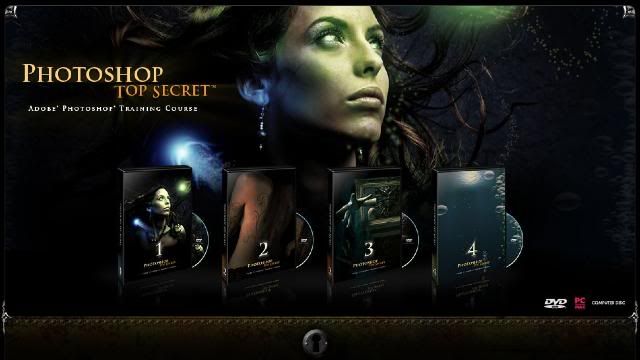
I found this great turorial.
How to Become a Photoshop "Black Belt"-Fast!Just released by Mark Monciardini, Photoshop Top Secret is an Extreme Training Course that teaches you, step by step, how to create cutting-edge graphics and special effects with Adobe Photoshop. This student-friendly home study course includes four DVD-ROMs with over 16 gigabytes of video tutorials and project files. It also comes with a full-color gallery book (printed, not pdf) that shows the end result of each project in the course. You can look, learn, practice, and master these advanced techniques wherever you may be, without the need for expensive classes or tutors. Create Posters, Movie Covers, Surreal Graphics and More!The course will teach you how to become the ultimate Photoshop "black belt" for fun and/or profit. You'll learn how to create top-level special effects for eye-catching movie posters, album covers, book jackets, brochures, mailing pieces, magazine covers, article illustrations, and a tremendously wide range of print ads and Web site graphics.
http://www.photoshoptopsecret.com/ Movie Poster I
Movie Poster ICreate a popular people montage seen on many movie posters.
LINK:
http://rapidshare.com/users/LA462P
Movie Poster IITake an ordinary house and turn it into a Sci-fi Movie Poster.
LINK:
http://rapidshare.com/files/50401418/Movie_Poster_II.part1.rar
http://rapidshare.com/files/50401400/Movie_Poster_II.part2.rar
http://rapidshare.com/files/50401624/Movie_Poster_II.part3.rar
http://rapidshare.com/files/50401409/Movie_Poster_II.part4.rar
Movie Poster CreditsTips and tricks on creating a real “Credit Block” for movie posters.
LINK:
http://rapidshare.com/files/50401376/Movie_Credits.part1.rar
http://rapidshare.com/files/50401383/Movie_Credits.part2.rar
http://rapidshare.com/files/50401535/Movie_Credits.part3.rar
http://rapidshare.com/files/50401285/Movie_Credits.part4.rar
Dark FacesHow I created my creepy Image that has been in Magazines and Ads.
LINK:
http://rapidshare.com/files/50401428/Dark_Faces.rar
Breaking ApartCreate the illusion that a face is falling apart.
LINK:
http://rapidshare.com/files/50402466/Break_Apart.part1.rar
http://rapidshare.com/files/50401560/Break_Apart.part2.rar
http://rapidshare.com/files/50401508/Break_Apart.part3.rar
http://rapidshare.com/files/50401311/Break_Apart.part4.rar
Dream Scene MontageCreate an elephant with wings and place it into a futuristic world.
LINK:
http://rapidshare.com/files/50401529/Dream_SceneMontage.part1.rar
http://rapidshare.com/files/50401668/Dream_SceneMontage.part2.rar
http://rapidshare.com/files/50401563/Dream_SceneMontage.part3.rar
http://rapidshare.com/files/50401278/Dream_SceneMontage.part4.rar
Stone PortraitCreate a “Stone Bust” out of a portrait for a killer special effect.
LINK:
http://rapidshare.com/files/50401623/Stone_Portrait.part1.rar
http://rapidshare.com/files/50401697/Stone_Portrait.part2.rar
http://rapidshare.com/files/50401886/Stone_Portrait.part3.rar
http://rapidshare.com/files/50401673/Stone_Portrait.part4.rar
http://rapidshare.com/files/50401756/Stone_Portrait.part5.rar
Surreal MistCreate a creamy foggy mist over water and rocks.
LINK:
http://rapidshare.com/files/50401540/Surreal_Mist.part1.rar
http://rapidshare.com/files/50401544/Surreal_Mist.part2.rar
http://rapidshare.com/files/50401580/Surreal_Mist.part3.rar
http://rapidshare.com/files/50401331/Surreal_Mist.part4.rar
Dream SkinCreate a fantasy woman with henna art and dream skin.
LINK:
http://rapidshare.com/files/50401589/Dream_Skin.part1.rar
http://rapidshare.com/files/50401759/Dream_Skin.part2.rar
http://rapidshare.com/files/50401429/Dream_Skin.part3.rar
http://rapidshare.com/files/50401323/Dream_Skin.part4.rar
Special EffectsLearn How to create Orbs, Fireballs and Jellyfish like creatures.
LINK:
http://rapidshare.com/files/50401314/Special_Effects.part1.rar
http://rapidshare.com/files/50401431/Special_Effects.part2.rar
http://rapidshare.com/files/50401417/Special_Effects.part3.rar
http://rapidshare.com/files/50401340/Special_Effects.part4.rar
http://rapidshare.com/files/50401318/Special_Effects.part5.rar
http://rapidshare.com/files/50401320/Special_Effects.part6.rar
http://rapidshare.com/files/50401415/Special_Effects.part7.rar
http://rapidshare.com/files/50401328/Special_Effects.part8.rar
http://rapidshare.com/files/50401308/Special_Effects.part9.rar
 Swapping Faces
Swapping FacesHow to take the face from one photo and place it into a completely different one.
LINK:
http://rapidshare.com/files/51023966/01_Intro.mov
http://rapidshare.com/files/51028936/02_Getting_Started.mov
http://rapidshare.com/files/51030721/03_Matching_Skin_Tones.mov
http://rapidshare.com/files/51032577/04_Face_Shadow_Secrets.mov
http://rapidshare.com/files/51035325/05_Skin_Matching_Secrets.mov
Pop ArtTurn a Photograph into artwork that was popular in the mid 1950’s.
LINK:
http://rapidshare.com/files/50496722/Pop_Art.part1.rar
http://rapidshare.com/files/50492866/Pop_Art.part2.rar
Applying TattoosHow to apply henna and tattoos to skin.
LINK:
http://rapidshare.com/files/50481136/Applying_Tattoo_s.part1.rar
http://rapidshare.com/files/50483392/Applying_Tattoo_s.part2.rar
Masking FurSeamlessly remove the background from furry animals.
LINK:
http://rapidshare.com/files/50485223/Masking_Fur.part1.rar
http://rapidshare.com/files/50487518/Masking_Fur.part2.rar
http://rapidshare.com/files/50489816/Masking_Fur.part3.rar
Vanishing PointWhat Vanishing Point is and how to edit images with perspective.
LINK:
http://rapidshare.com/files/50507223/Vanishing_Point.part1.rar
http://rapidshare.com/files/50511659/Vanishing_Point.part2.rar
Web GraphicsLearn how to create commonly used web graphics and screen shots.
LINK:
http://rapidshare.com/files/50520851/Elegant_Headers.rar
http://rapidshare.com/files/50526991/Logo_Basics.rar
http://rapidshare.com/files/50532499/Download_Button.rar
http://rapidshare.com/files/50543201/Seal_of_Guarantee.rar
http://rapidshare.com/files/50552172/Screen_Captures__PC_.rar
http://rapidshare.com/files/50545451/Screen_Captures__Mac_.rar
http://rapidshare.com/files/50549863/Subscribe_Button.rar
http://rapidshare.com/files/50558175/Order_Button.rar
http://rapidshare.com/files/50559384/Computer_Screen_Images.rar
Shattered TypeCreate the illusion that text is being shattered like glass.
LINK:
http://rapidshare.com/files/50500038/Shattered_Type.part1.rar
http://rapidshare.com/files/50503596/Shattered_Type.part2.rar
Flower Greeting CardUse the vector tools in Photoshop to create an elegant looking Greeting Card.
LINK:
http://rapidshare.com/files/50468558/Flower_Greeting_Card.part1.rar
http://rapidshare.com/files/50475456/Flower_Greeting_Card.part2.rar
http://rapidshare.com/files/50470571/Flower_Greeting_Card.part3.rar
Creating DVD CoversMark shows you exactly how he created the Photoshop Top Secret DVD covers.
LINK:
http://rapidshare.com/files/50479036/Creating_DVD_Cover_s.part1.rar
http://rapidshare.com/files/50477320/Creating_DVD_Cover_s.part2.rar

Flying out of BoundsCreate the classic “out of bounds” effect with a very cool masking trick.
LINK:
http://rapidshare.com/files/53854880/-__Feersum__-FlyingOOB.part1.rar
http://rapidshare.com/files/53858779/-__Feersum__-FlyingOOB.part2.rar
http://rapidshare.com/files/53851192/-__Feersum__-FlyingOOB.part3.rar
Reaching out of BoundsCreating the illusion of arms and hands reaching out of a picture frame.
LINK:
http://rapidshare.com/files/51278203/Reaching_Out_of_Bounds.part1.rar
http://rapidshare.com/files/51282073/Reaching_Out_of_Bounds.part2.rar
Chocolate Milk FrogHow to make a frog covered in chocolate.
LINK:
http://rapidshare.com/files/51090808/Chocolate_Milk_Frog.part1.rar
http://rapidshare.com/files/51093773/Chocolate_Milk_Frog.part2.rar
http://rapidshare.com/files/51098112/Chocolate_Milk_Frog.part3.rar
http://rapidshare.com/files/51100483/Chocolate_Milk_Frog.part4.rar
http://rapidshare.com/files/51104392/Chocolate_Milk_Frog.part5.rar
Covered with WaxChoose an object and cover it with melting wax.
LINK:
http://rapidshare.com/files/51106691/Covered_With_Wax.part1.rar
http://rapidshare.com/files/51109790/Covered_With_Wax.part2.rar
http://rapidshare.com/files/51112318/Covered_With_Wax.part3.rar
Grunge LookCreate a unique grunge background that can be used for almost anything.
LINK:
http://rapidshare.com/files/51192260/The_Grunge_Look.part1.rar
http://rapidshare.com/files/51196157/The_Grunge_Look.part2.rar
http://rapidshare.com/files/51200111/The_Grunge_Look.part3.rar
Square FruitPlay with mother nature by changing the shape of fruit.
LINK:
http://rapidshare.com/files/51287450/Square_Fruit.part1.rar
http://rapidshare.com/files/51291484/Square_Fruit.part2.rar http://rapidshare.com/files/51718794/Square_Fruit.part3.rar
Invisible ManHow to make a person vanish from their clothing.
LINK:
http://rapidshare.com/files/51205433/Invisible_Man.part1.rar
http://rapidshare.com/files/51210895/Invisible_Man.part2.rar
http://rapidshare.com/files/51216175/Invisible_Man.part3.rar
Metal CollageHow to create a Robot with pieces of a Photo and then place it into another world.
LINK:
http://rapidshare.com/files/51223497/Metal_Collage.part1.rar
http://rapidshare.com/files/51228285/Metal_Collage.part2.rar
Morphing CreaturesMorph animals and reptiles together to create interesting creatures.
LINK:
http://rapidshare.com/files/51252979/Morphing_Creatures.part1.rar
http://rapidshare.com/files/51259915/Morphing_Creatures.part2.rar
http://rapidshare.com/files/51264571/Morphing_Creatures.part3.rar
http://rapidshare.com/files/51272001/Morphing_Creatures.part4.rar
Using Layer CompsHow to create multiple layouts in one Photoshop file using Layer Comps.
LINK:
http://rapidshare.com/files/51219597/Layer_Comps.part1.rar
 Vector Art Portrait
Vector Art PortraitTurn a Photograph into beautiful vector art.
LINK:
http://rapidshare.com/files/51851146/Vector_Art_Portrait.part1.rar
http://rapidshare.com/files/51856684/Vector_Art_Portrait.part2.rar
http://rapidshare.com/files/51865053/Vector_Art_Portrait.part3.rar
http://rapidshare.com/files/51877688/Vector_Art_Portrait.part4.rar
http://rapidshare.com/files/51887762/Vector_Art_Portrait.part5.rar
http://rapidshare.com/files/51895918/Vector_Art_Portrait.part6.rar
Dreamy BackgroundCreate Sci-fi looking spiral backgrounds.
LINK:
http://rapidshare.com/files/51748767/Dreamy_Backgrounds.part1.rar
Liquid MetalThe ultimate Liquid metal technique that can be applied to text and objects.
LINK:
http://rapidshare.com/files/51751193/Liquid_Metal.part1.rar
http://rapidshare.com/files/51755087/Liquid_Metal.part2.rar
http://rapidshare.com/files/51758424/Liquid_Metal.part3.rar
http://rapidshare.com/files/51759757/Liquid_Metal.part4.rar
SmokeCreate Psychedelic and Natural Smoke to incorporate into your artwork.
LINK:
http://rapidshare.com/files/51776133/Smoke.part1.rar
http://rapidshare.com/files/51780548/Smoke.part2.rar
Soap BubblesUse soap bubbles to add flair to your projects.
LINK:
http://rapidshare.com/files/51784928/Soap_Bubbles.part1.rar
http://rapidshare.com/files/51791004/Soap_Bubbles.part2.rar
Water BubblesUse these water bubbles to infuse imagination into your projects.
LINK:
http://rapidshare.com/files/51909867/Water_Bubbles.part1.rar
Underwater SceneCreate an underwater illusion with just the tools in Photoshop.
LINK:
http://rapidshare.com/files/51846287/Underwater_Scene.part1.rar
Swap Animal SkinTake skin from one animal and place it over another.
LINK:
http://rapidshare.com/files/51836472/Swap_Animal_Skin.part1.rar
Stylized CharacterTurn a sketch into colorful art.
LINK:
http://rapidshare.com/files/51796685/Stylized_Character.part1.rar
http://rapidshare.com/files/51804210/Stylized_Character.part2.rar
http://rapidshare.com/files/51815699/Stylized_Character.part3.rar
http://rapidshare.com/files/51825512/Stylized_Character.part4.rar
Masking MasterySpecial video that explains many masking techniques used by the pros.
LINK:
http://rapidshare.com/files/51762273/Masking_Mastery.part1.rar
http://rapidshare.com/files/51766415/Masking_Mastery.part2.rar
http://rapidshare.com/files/51768184/Masking_Mastery.part3.rar
http://rapidshare.com/files/51770219/Masking_Mastery.part4.rar
--------------------------------------------------------------------------------------------------------------------------------
Project Files/Exercise FilesDVD 1LINK:
http://rapidshare.com/files/50566319/Project_Files.part01.rar
http://rapidshare.com/files/50572676/Project_Files.part02.rar
http://rapidshare.com/files/50584119/Project_Files.part03.rar
http://rapidshare.com/files/50591357/Project_Files.part04.rar
http://rapidshare.com/files/50598245/Project_Files.part05.rar
http://rapidshare.com/files/50606188/Project_Files.part06.rar
http://rapidshare.com/files/50608594/Project_Files.part07.rar
DVD 2LINK:
http://rapidshare.com/files/53264692/-__Feersum__-PSec-2-Proj.part1.rar
http://rapidshare.com/files/53265853/-__Feersum__-PSec-2-Proj.part2.rar
DVD 3LINK:
http://rapidshare.com/files/51180564/Project_Files.part1.rar
http://rapidshare.com/files/51184147/Project_Files.part2.rar
http://rapidshare.com/files/51187840/Project_Files.part3.rar
DVD 4LINK:
http://rapidshare.com/files/51730477/Project_Files.part1.rar
http://rapidshare.com/files/51734240/Project_Files.part2.rar
http://rapidshare.com/files/51736922/Project_Files.part3.rar
Theirs also a
Gallerybook included
Download:
LINK:
http://rapidshare.com/files/50616998/DVD_Covers_and_Labels.zip
http://rapidshare.com/files/50612698/Photoshop_TopSecret_Gallery_Book.pdf.zip
Torrents If Interested
http://rapidshare.com/files/49495944/Photoshop_Torrents.zip
The links work for now so download before they remove them















